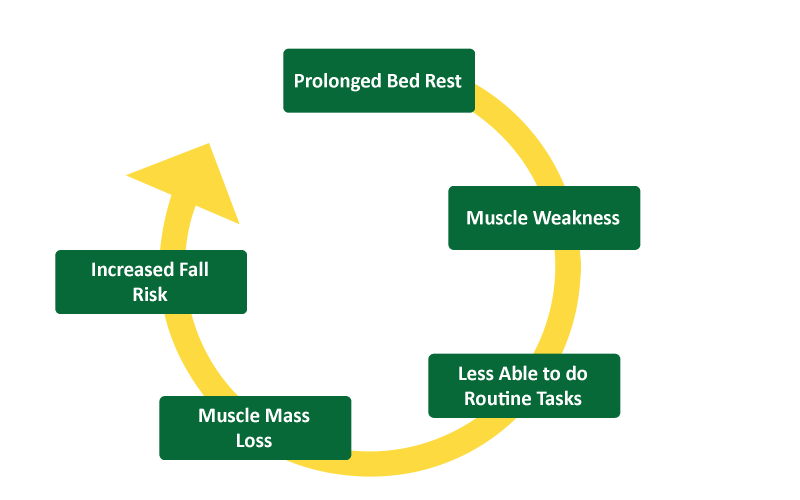Long COVID Self-Management - Safely Returning to Activity
Effects of Deconditioning
After spending time recovering from COVID-19, your body may have become deconditioned. This means that you are weaker, your body is less flexible and you have less muscle because of all the time spent being sick in bed or resting. This can lead to issues with balance and coordination, which increases the chance of a fall happening. Also, a person becomes more tired and less motivated to work on regaining their strength.
Other Effects of Deconditioning
- You may feel tired.
- Your thoughts may become confused.
- Your heart and blood circulation becomes weakened. This may cause difficulty with keeping your blood pressure stable, leading to dizziness.
- Your weakened muscles may hurt with movement. So, you may get muscle spasms, cramps, and feelings of electric shock with simple activities.
- The structures connecting your bones to your muscles (i.e. joints, ligaments tendons) may become stiff. This can lead to pain during activity.
All of this can affect your mood. Simple activities like taking a shower, grocery shopping, making a meal, or climbing the stairs can be exhausting. Some people are afraid to become active again. Others feel helpless or hopeless.
Did You Know?
- Ten days of bed rest in hospital leads to about 10 years of muscle aging in people over 80 years of age. (Kortbein et al 2004 J Gerontology)
- Visit Alberta Health for more information about deconditioning and physical activity:
Being Active and Setting Your Goals
Being active has a positive impact on your body and mind. It is important to be kind to yourself. Small gains count. By starting slow and gradually increasing activity, you begin the healing process. You may not notice positive results right away, but every effort to be active will strengthen your body and increase muscle mass.
Setting goals that you can hit is a great way to keep tabs on your progress and keep you on task when you start exercising. Goal setting will help you plan what you want to accomplish. After completing a goal, you can reflect on what went well or what you need to change to achieve it next time. You could also use a daily log to monitor your progress and help keep you motivated. Returning to activity looks different for each person. It may include starting with gentle breathing exercises and typical daily chores. It could also include stretching and strength exercises. There are some guidelines below that will help you figure out when to return to activity and proceed with exercise.
No matter what type of activities you are doing, discipline will be needed to start a routine. It will also be important to pace yourself. One idea is to start doing a little bit of activity during the day and add more as time goes by. After a while, doing regular activities at home and in the community becomes easier and more enjoyable.
Returning to Activity Post COVID-19
Keeping an exercise diary can help track physical progress and changes in mood. There are a variety of symptoms that can occur after a person recovers from COVID-19, so every person's recovery will be unique. You are encouraged to work with your medical professional on an exercise program that suits your needs.
Visit Exercises for information that will help you move through the activity phases. These are aimed to stretch and strengthen all the major muscle groups. You may decide to work on your upper body one day, lower body the next, and another day on your core or balance.
There can be risk tied in with exercise and may result in injury if not done properly. It is important to talk to your medical team regarding any changes that you might need to make to the exercise program.



